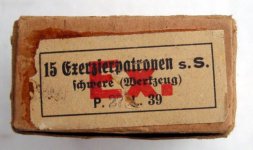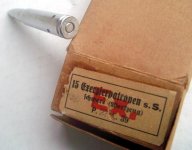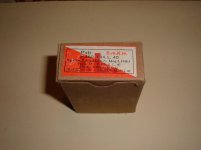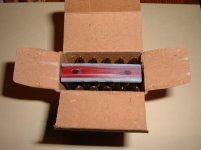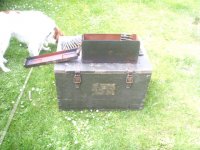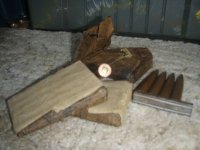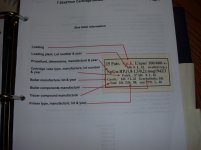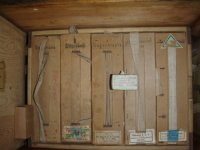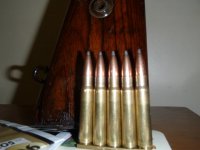You are using an out of date browser. It may not display this or other websites correctly.
You should upgrade or use an alternative browser.
You should upgrade or use an alternative browser.
Anybody got K98k ammunition(then let,s see it)tracers/ball/steel/brass/
- Thread starter bjarne
- Start date
jack944
Senior Member
How to get book
This is an answer I got:
Dear Mr. Miller,
I presume, that you live in the USA od Canada.
Total cost of the 7,9 book:
Book € 40,--
English text brochure € 5,--
Postage fast mail € 25,50
Postage surface mail € 19,50
Total air mail € 70,50
Total slow € 64,50
Please chose fast or slow and transfer the money via paypal od bank transfer without any expenses for me in Euros.
Give me your postal address!
e-mail: kontor@waffenbuecher.com
www.waffenbuecher.com
Sincerely
Mag.iur. Josef MÖTZ
Selbstverlag und Publizistisches Archiv für Waffen- und Munitionskunde
A-2361 LAXENBURG, Herbert Rauch-Gasse 11
Tel.:+43(0)664-6221441
Fax: +43(0)2236-710357
This is an answer I got:
Dear Mr. Miller,
I presume, that you live in the USA od Canada.
Total cost of the 7,9 book:
Book € 40,--
English text brochure € 5,--
Postage fast mail € 25,50
Postage surface mail € 19,50
Total air mail € 70,50
Total slow € 64,50
Please chose fast or slow and transfer the money via paypal od bank transfer without any expenses for me in Euros.
Give me your postal address!
e-mail: kontor@waffenbuecher.com
www.waffenbuecher.com
Sincerely
Mag.iur. Josef MÖTZ
Selbstverlag und Publizistisches Archiv für Waffen- und Munitionskunde
A-2361 LAXENBURG, Herbert Rauch-Gasse 11
Tel.:+43(0)664-6221441
Fax: +43(0)2236-710357
bjarne
Senior Member
Training patronen
five training patronen on stripper clip(date 44)
one ex patronen(date39)

five training patronen on stripper clip(date 44)
one ex patronen(date39)

Attachments
bjarne
Senior Member
NRA
Well-known member
a box of chrome plated tool cartridges.
at the risk of sounding dumb, what the he** ...... chrome?
haak48
Senior Member
German 7,9 boxes/crates
Tungsten carbide core Smk-H, P490 134L 40, (on clips) first model, GMCS bullet, all red primer, red stripe on chargers. JH
Tungsten carbide core Smk-H, P490 134L 40, (on clips) first model, GMCS bullet, all red primer, red stripe on chargers. JH
Attachments
pzjgr
EOD - bombs and bullets
at the risk of sounding dumb, what the he** ...... chrome?
Yep, purpose made tool (excercise) cartridges were chromed, not sue why..maybe for smoothness in the action, and for protection?..I have a similiar box, but my label is pretty rough.
It is a fairly scarce item, expecially complete boxes...I have read on the IAA forum they go for pretty good bucks on a per cartridge basis...I lucked into mine, guy offered the box to me at a show, I asked how much, he said $12....I had the money out in a flash!
ETA And you want to see a box of ammo almost worth its weight in gold...see Jims box of Smk-H....that is a holy grail for German military cartridge collectors! Jim has some AMAZING stuff!!
bjarne
Senior Member
once again NICE
I have been looking for those
proberly impossible to find here in Denmark WHY cause you got them all
Tungsten carbide core Smk-H, P490 134L 40, (on clips) first model, GMCS bullet, all red primer, red stripe on chargers. JH
I have been looking for those

proberly impossible to find here in Denmark WHY cause you got them all

agalland
Well-known member
Somewhere , on some forum,I saw a posting with a pic that detailed what each section and piece of info on the Box flap tag on german ammo stood for.
It was great for identifying every aspect of the ammo.
I know that is pretty vague....but does it ring a bell for anyone....?
Thanks...Steve
It was great for identifying every aspect of the ammo.
I know that is pretty vague....but does it ring a bell for anyone....?
Thanks...Steve
haak48
Senior Member
German 7,9 boxes/crates
Here you go Steve. JHSomewhere , on some forum,I saw a posting with a pic that detailed what each section and piece of info on the Box flap tag on german ammo stood for.
It was great for identifying every aspect of the ammo.
I know that is pretty vague....but does it ring a bell for anyone....?
Thanks...Steve
Attachments
bjarne
Senior Member
Original Ammo wanted.
Anyone got any originals to sell? In Australia i actually have trouble finding new 8mm mauser ammo Let alone old surplus all the old war vets mustve got back with all their hoardes n blasted a heap of rabbits n roos! Í Currently have 100new Highland Tax rounds (80 of which r empty) and cant get any more so i purchased a reloader but hanging for a box of originals to add to collection also stripper clips ? Anyone? I'm Willing to pay the $$$. And dude how many rounds are in them boxes ? Bloody lucky bugger
? Bloody lucky bugger .
.
Anyone got any originals to sell? In Australia i actually have trouble finding new 8mm mauser ammo Let alone old surplus all the old war vets mustve got back with all their hoardes n blasted a heap of rabbits n roos! Í Currently have 100new Highland Tax rounds (80 of which r empty) and cant get any more so i purchased a reloader but hanging for a box of originals to add to collection also stripper clips ? Anyone? I'm Willing to pay the $$$. And dude how many rounds are in them boxes
 ? Bloody lucky bugger
? Bloody lucky bugger .
.Attachments
Last edited:
GunKraut
Senior Member
I prefer the 30/40 primed sS for German auto loading rifles when I can find serviceable lots. ... G41/43 series of rifles.
This is machine gun ammo. Are you seriously running this stuff through your G41 or G43?
haak48
Senior Member
"fur MG"
The marking of "fur MG" on the box label does not refer to the ammunition's suitability for a particular type of weapon in German WW2 service. It was first widely used to distinguish CWS cartridge cases, which was being reserved for rifles, from the then new and problematic lacquered steel case. Boxes not marked "fur MG" were sometimes simply marked "lacquer". Later, it came to be widely used to mean "loose packed" cartridges, or no chargers, when the o.L. marking was dropped. The loading is the same as the non "fur MG" marked ammo. The -v- ammunition, (improved) can still be used in standard German rifles and machine guns, though some MG's had to have blast cones replaced to fire reliably with the -v- cartridges. The Smk-H cartridge was the first true -v- loading, and was marked in various ways to indicate on or off clips or "fur MG". Same round, different order. Though -v- cartridges truly are high pressure loadings, to repeat, they can be used in standard weapons. The Smk-v- was a favorite of some snipers in k98 rifles. Ammunition orders came in to depots from field commanders with so many rounds to be on clips, so many "fur MG", and so on. Repacked 7,9 generaly just has the 1500 round case label or sleeve seal marked with changes from "i.L. to "furMG" or the other way around. 15 round boxes were not always marked when changes were made. The Battle of the Bulge was late in the war but commanders ordered that all cartridges stockpiled for the event be loaded in brass cases. The Russian campaign had caused them to distrust the steel 7,9 cases. That is why large amounts of Sme, Smk'l &Smk are found in 1944 loadings in brass cases, most 30/40 primed. All box markings are seen for the same loading lots of this ammo, i.L, fur MG, etc. JH
The marking of "fur MG" on the box label does not refer to the ammunition's suitability for a particular type of weapon in German WW2 service. It was first widely used to distinguish CWS cartridge cases, which was being reserved for rifles, from the then new and problematic lacquered steel case. Boxes not marked "fur MG" were sometimes simply marked "lacquer". Later, it came to be widely used to mean "loose packed" cartridges, or no chargers, when the o.L. marking was dropped. The loading is the same as the non "fur MG" marked ammo. The -v- ammunition, (improved) can still be used in standard German rifles and machine guns, though some MG's had to have blast cones replaced to fire reliably with the -v- cartridges. The Smk-H cartridge was the first true -v- loading, and was marked in various ways to indicate on or off clips or "fur MG". Same round, different order. Though -v- cartridges truly are high pressure loadings, to repeat, they can be used in standard weapons. The Smk-v- was a favorite of some snipers in k98 rifles. Ammunition orders came in to depots from field commanders with so many rounds to be on clips, so many "fur MG", and so on. Repacked 7,9 generaly just has the 1500 round case label or sleeve seal marked with changes from "i.L. to "furMG" or the other way around. 15 round boxes were not always marked when changes were made. The Battle of the Bulge was late in the war but commanders ordered that all cartridges stockpiled for the event be loaded in brass cases. The Russian campaign had caused them to distrust the steel 7,9 cases. That is why large amounts of Sme, Smk'l &Smk are found in 1944 loadings in brass cases, most 30/40 primed. All box markings are seen for the same loading lots of this ammo, i.L, fur MG, etc. JH
GunKraut
Senior Member
Thank you for the in-depth information. I also have a few of these boxes in my stash but the "für MG" label has always deterred me from running them through my rifles, not only the semi-automatics but my K98's as well. Maybe I'll give it a try one day, unless the ammo is considered somehow collectible and better be left sitting in my display case.






